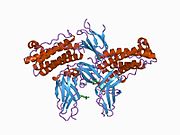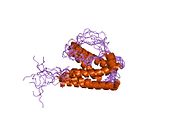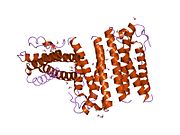Granulocyte colony-stimulating factor
Ensembl | |||||||||
|---|---|---|---|---|---|---|---|---|---|
| UniProt | |||||||||
| RefSeq (mRNA) | |||||||||
| RefSeq (protein) | |||||||||
| Location (UCSC) | Chr 17: 40.02 – 40.02 Mb | Chr 11: 98.59 – 98.59 Mb | |||||||
| PubMed search | [3] | [4] | |||||||
| View/Edit Human | View/Edit Mouse |
Granulocyte colony-stimulating factor (G-CSF or GCSF), also known as colony-stimulating factor 3 (CSF 3), is a
Functionally, it is a
G-CSF also stimulates the survival, proliferation, differentiation, and function of neutrophil precursors and mature neutrophils.
Biological function
G-CSF is produced by endothelium, macrophages, and a number of other immune cells. The natural human glycoprotein exists in two forms, a 174- and 177-amino-acid-long protein of molecular weight 19,600 grams per mole. The more-abundant and more-active 174-amino acid form has been used in the development of pharmaceutical products by recombinant DNA (rDNA) technology.[citation needed]
- White blood cells
- The phosphatidylinositol 3-kinase (PI3K)/protein kinase B (Akt) signal transduction pathway.[citation needed]
- Hematopoietic System
- G-CSF is also a potent inducer of hematopoietic stem cell (HSC) mobilization from the bone marrow into the bloodstream, although it has been shown that it does not directly affect the hematopoietic progenitors that are mobilized.[7]
- Neurons
- G-CSF can also act on neuronal cells as a neurotrophic factor. Indeed, its receptor is expressed by neurons in the brain and spinal cord. The action of G-CSF in the central nervous system is to induce cerebral ischemia.[citation needed]
Genetics
The gene for G-CSF is located on
The two polypeptides differ by the presence or absence of three amino acids. Expression studies indicate that both have authentic GCSF activity.[citation needed]
It is thought that stability of the G-CSF mRNA is regulated by an RNA element called the G-CSF factor stem-loop destabilising element.[citation needed]
Medical use
Chemotherapy-induced neutropenia
Chemotherapy can cause
G-CSF was first trialled as a therapy for neutropenia induced by chemotherapy in 1988. The treatment was well tolerated and a dose-dependent rise in circulating neutrophils was noted.[14]
A study in mice has shown that G-CSF may decrease
G-CSF administration has been shown to attenuate the telomere loss associated with chemotherapy.[16]
Use in drug-induced neutropenia
Before blood donation
G-CSF is also used to increase the number of
Stem cell transplants
G-CSF may also be given to the receiver in
Side effect
The skin disease
History
Mouse granulocyte-colony stimulating factor (G-CSF) was first recognised and purified in
The FDA approved the first biosimilar of Neulasta in June 2018. It is made by Mylan and sold as Fulphila.[23]
Pharmaceutical variants
The
Filgrastim was first marketed by
Another form of rhG-CSF called lenograstim is synthesised in Chinese hamster ovary cells (CHO cells). As this is a mammalian cell expression system, lenograstim is indistinguishable from the 174-amino acid natural human G-CSF. No clinical or therapeutic consequences of the differences between filgrastim and lenograstim have yet been identified, but there are no formal comparative studies.
Research
G-CSF when given early after exposure to radiation may improve white blood cell counts, and is stockpiled for use in radiation incidents.[24][25]
G-CSF has been shown to reduce inflammation, reduce amyloid beta burden, and reverse cognitive impairment in a mouse model of Alzheimer's disease.[27]
Due to its neuroprotective properties, G-CSF is currently under investigation for
See also
References
- ^ a b c GRCh38: Ensembl release 89: ENSG00000108342 – Ensembl, May 2017
- ^ a b c GRCm38: Ensembl release 89: ENSMUSG00000038067 – Ensembl, May 2017
- ^ "Human PubMed Reference:". National Center for Biotechnology Information, U.S. National Library of Medicine.
- ^ "Mouse PubMed Reference:". National Center for Biotechnology Information, U.S. National Library of Medicine.
- S2CID 20774089.
- PMID 27943116.
- S2CID 5774130.
- PMID 16007267.
- PMID 18835867.
- ^ S2CID 4325026.
- PMID 23788754.
- ^ "Granulocyte colony stimulating factor (G-CSF)". Cancer Research UK. Retrieved 12 November 2014.
- PMID 26343861.
- S2CID 21255495.
- PMID 17192391.
- ^ S2CID 5785335.
- PMID 28747065.
- S2CID 41269943.
- ^ PMID 23287427.
- S2CID 414133.
- S2CID 45170361.
- PMID 2420009.
- ^ Commissioner Oo (2019-09-11). "Press Announcements - FDA approves first biosimilar to Neulasta to help reduce the risk of infection during cancer treatment". www.fda.gov.
- PMID 16737941.
- PMID 18287516.
- ISBN 978-0-7333-1248-9.
- PMID 19500657.
- ^ "AXIS 2: AX200 for the Treatment of Ischemic Stroke - Full Text View - ClinicalTrials.gov". clinicaltrials.gov.
- S2CID 43087598.
- PMID 24621603.
Further reading
- Duarte RF, Franf DA (June 2002). "The synergy between stem cell factor (SCF) and granulocyte colony-stimulating factor (G-CSF): molecular basis and clinical relevance". Leukemia & Lymphoma. 43 (6): 1179–87. S2CID 45748453.
- Mroczko B, Szmitkowski M (2005). "Hematopoietic cytokines as tumor markers". Clinical Chemistry and Laboratory Medicine. 42 (12): 1347–54. S2CID 11414705.
- Sallerfors B, Olofsson T (October 1992). "Granulocyte-macrophage colony-stimulating factor (GM-CSF) and granulocyte colony-stimulating factor (G-CSF) secretion by adherent monocytes measured by quantitative immunoassays". European Journal of Haematology. 49 (4): 199–207. S2CID 35573524.
- Zink T, Ross A, Ambrosius D, Rudolph R, Holak TA (December 1992). "Secondary structure of human granulocyte colony-stimulating factor derived from NMR spectroscopy". FEBS Letters. 314 (3): 435–9. S2CID 28422738.
- Kubota N, Orita T, Hattori K, Oh-eda M, Ochi N, Yamazaki T (March 1990). "Structural characterization of natural and recombinant human granulocyte colony-stimulating factors". Journal of Biochemistry. 107 (3): 486–92. PMID 1692828.
- Nagata S, Tsuchiya M, Asano S, Yamamoto O, Hirata Y, Kubota N, Oheda M, Nomura H, Yamazaki T (March 1986). "The chromosomal gene structure and two mRNAs for human granulocyte colony-stimulating factor". The EMBO Journal. 5 (3): 575–81. PMID 2423327.
- Simmers RN, Smith J, Shannon MF, Wong G, Lopez AF, Baker E, S2CID 469736.
- Tweardy DJ, Cannizzaro LA, Palumbo AP, Shane S, Huebner K, Vantuinen P, Ledbetter DH, Finan JB, Nowell PC, Rovera G (August 1987). "Molecular cloning and characterization of a cDNA for human granulocyte colony-stimulating factor (G-CSF) from a glioblastoma multiforme cell line and localization of the G-CSF gene to chromosome band 17q21". Oncogene Research. 1 (3): 209–20. PMID 2453015.
- Tsuchiya M, Nomura H, Asano S, Kaziro Y, Nagata S (March 1987). "Characterization of recombinant human granulocyte-colony-stimulating factor produced in mouse cells". The EMBO Journal. 6 (3): 611–6. PMID 3034599.
- Devlin JJ, Devlin PE, Myambo K, Lilly MB, Rado TA, Warren MK (April 1987). "Expression of granulocyte colony-stimulating factor by human cell lines". Journal of Leukocyte Biology. 41 (4): 302–6. S2CID 26877622.
- Kanda N, Fukushige S, Murotsu T, Yoshida MC, Tsuchiya M, Asano S, Kaziro Y, Nagata S (November 1987). "Human gene coding for granulocyte-colony stimulating factor is assigned to the q21-q22 region of chromosome 17". Somatic Cell and Molecular Genetics. 13 (6): 679–84. S2CID 10909775.
- Le Beau MM, Lemons RS, Carrino JJ, Pettenati MJ, Souza LM, Diaz MO, Rowley JD (December 1987). "Chromosomal localization of the human G-CSF gene to 17q11 proximal to the breakpoint of the t(15;17) in acute promyelocytic leukemia". Leukemia. 1 (12): 795–9. PMID 3501046.
- Zink T, Ross A, Lüers K, Cieslar C, Rudolph R, Holak TA (July 1994). "Structure and dynamics of the human granulocyte colony-stimulating factor determined by NMR spectroscopy. Loop mobility in a four-helix-bundle protein". Biochemistry. 33 (28): 8453–63. PMID 7518249.
- Corcione A, Baldi L, Zupo S, Dono M, Rinaldi GB, Roncella S, Taborelli G, Truini M, Ferrarini M, Pistoia V (October 1994). "Spontaneous production of granulocyte colony-stimulating factor in vitro by human B-lineage lymphocytes is a distinctive marker of germinal center cells". Journal of Immunology. 153 (7): 2868–77. S2CID 25302361.
- Watari K, Ozawa K, Tajika K, Tojo A, Tani K, Kamachi S, Harigaya K, Takahashi T, Sekiguchi S, Nagata S (July 1994). "Production of human granulocyte colony stimulating factor by various kinds of stromal cells in vitro detected by enzyme immunoassay and in situ hybridization". Stem Cells. 12 (4): 416–23. S2CID 22671177.
- Hill CP, Osslund TD, Eisenberg D (June 1993). "The structure of granulocyte-colony-stimulating factor and its relationship to other growth factors". Proceedings of the National Academy of Sciences of the United States of America. 90 (11): 5167–71. PMID 7685117.
- Haniu M, Horan T, Arakawa T, Le J, Katta V, Rohde MF (December 1995). "Extracellular domain of granulocyte-colony stimulating factor receptor. Interaction with its ligand and identification of a domain in close proximity of ligand-binding region". Archives of Biochemistry and Biophysics. 324 (2): 344–56. PMID 8554326.
- McCracken S, Layton JE, Shorter SC, Starkey PM, Barlow DH, Mardon HJ (May 1996). "Expression of granulocyte-colony stimulating factor and its receptor is regulated during the development of the human placenta". The Journal of Endocrinology. 149 (2): 249–58. PMID 8708536.
External links
- Granulocyte+Colony-Stimulating+Factor at the U.S. National Library of Medicine Medical Subject Headings (MeSH)
- Overview of all the structural information available in the PDB for UniProt: P09919 (Granulocyte colony-stimulating factor) at the PDBe-KB.





